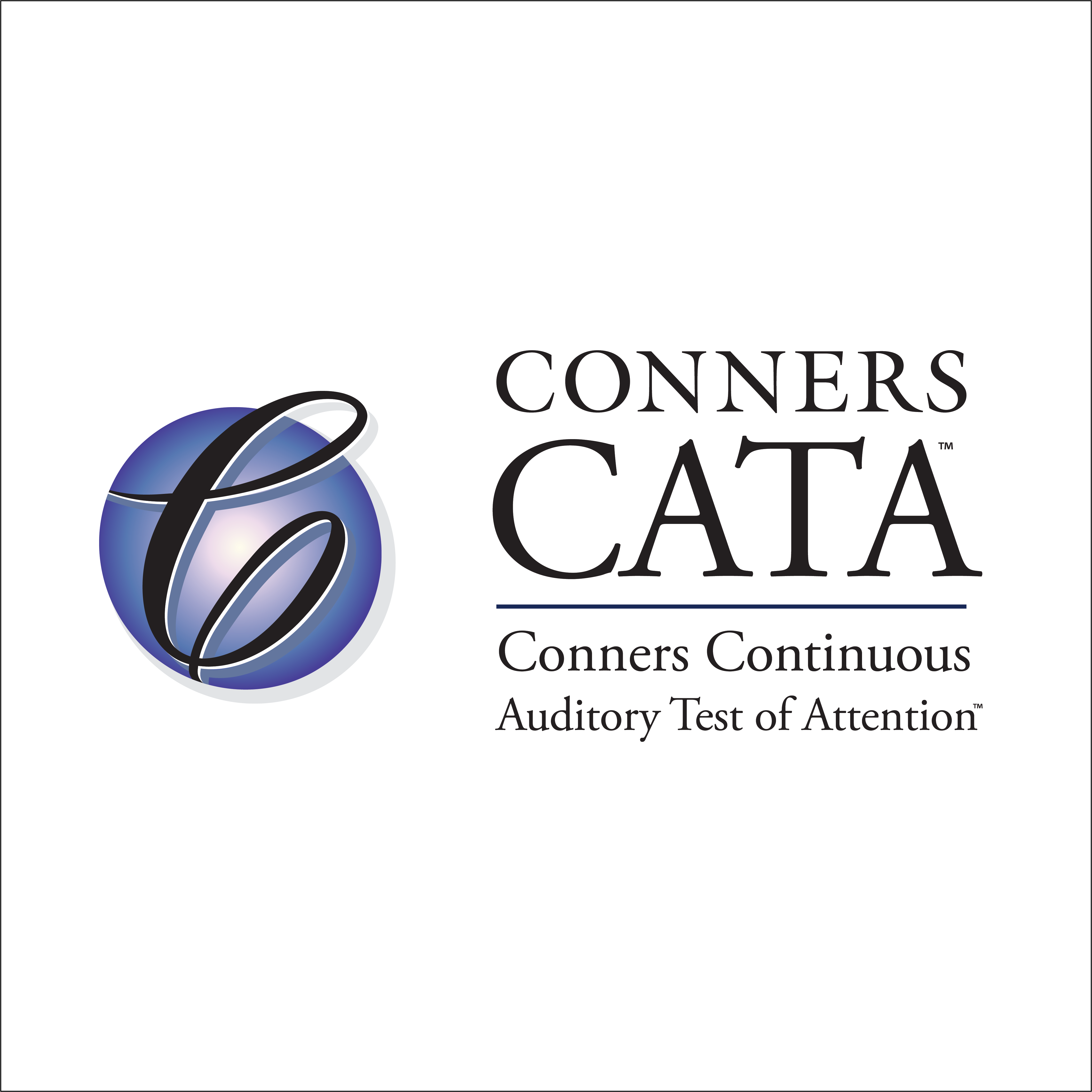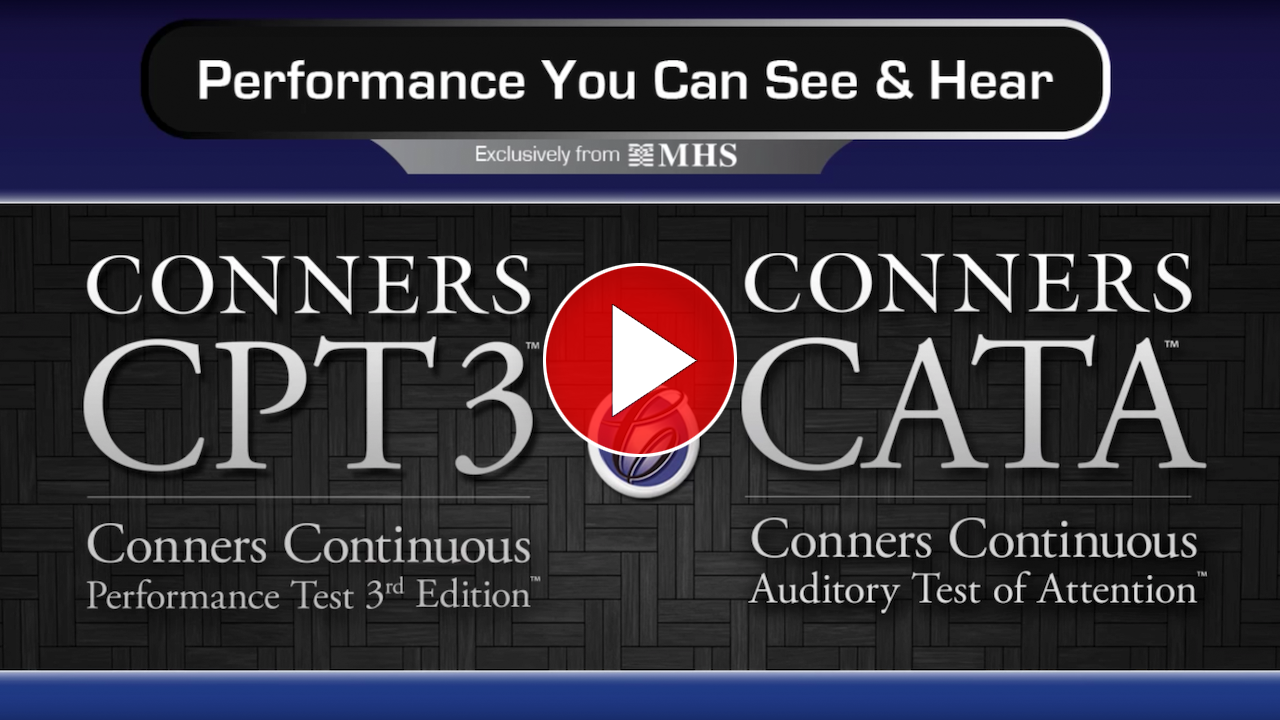
Conners CATA®
Conners Continuous Auditory Test of Attention®

The Conners Continuous Auditory Test of Attention ® (Conners CATA ® ) measures a respondent's performance in areas of inattentiveness, impulsivity, and sustained attention, making it a useful tool in evaluating attention disorders and neurological functioning. The Conners CATA provides objective information about an individual's performance in attention tasks, complementing information obtained from rating scales such as the Conners 3.
For a more in-depth assessment of attention, the Conners CATA can also be used in conjunction with the Conners Continuous Performance Test Third Edition ™ (Conners CPT 3 ™ ), which is a task-oriented computerized assessment of attention-related problems in individuals aged eight years and older. The Conners CATA and Conners CPT 3 can be purchased as a combo kit or individually. Click here to learn more about the Conners CPT 3.
Age
- 8+
Administration Type
- Self
Administration Time
- 14 Minutes
Qualification Level
- B
Format(s)
- Software (Administration & Scoring)
System Requirements
- x86 processor 1.0ghz - class computer or higher
- Windows 2000 Service Pack 3 or higher
- Windows XP computers should have Service Pack 2 or higher installed for the Microsoft .NET Framework v2.0
- MDAC 2.6 or higher
- 1 gigabyte of RAM memory or higher
- 500 megabytes of hard disk space
- USB 2.0 port
- Easy-to-interpret reports that offer clear visuals and summaries of scores
- Trusted results with the most representative CPT normative samples collected
- Easy-to-understand clinical likelihood statements that are based on T-scores and displayed as very high, high, moderate, or minimal
- Descriptive information about the respondent’s auditory laterality and mobility
- Results sorted by block
Assessment Reports provide detailed information about scores from a single administration, presented both numerically and graphically. An individual's scores are compared to those in the normative sample and elevations at the scale and subscale level are indicated.
Progress Reports compare the results of two to four administrations for the same individual to measure changes over time. These reports are ideal to use when monitoring treatment and intervention effectiveness.
During the 14-minute, 200-trial administration, respondents are presented with high-tone sounds that are either preceded by a low-tone warning sound (warned trials) or played alone (unwarned trials). Respondents are instructed to respond only to high-tone sounds on warned trials and to ignore those on unwarned trials. On most trials, the low-tone and the high-tone sounds are played in the same ear (non-switch trials). On switch trials, the low-tone warning sound and the high-tone target sound are played in different ears, requiring the respondent to shift auditory attention from one ear to the other.
Reliability
Users can be confident that the Conners CATA will yield consistent and stable scores across administrations.
Internal Consistency
One measure of a test's internal consistency is split-half reliability, which has been previously used to establish the reliability of other continuous performance tests. Split-half reliability estimates of the Conners CATA scales were calculated for the normative and clinical samples. Results were very strong; across all scores, the median split-half reliability estimate was .95 for the norm and clinical samples (all correlations were significant, p < .001). These results indicate that the Conners CATA demonstrates excellent internal consistency for both the normative and clinical groups.
Test-Retest Reliability
Test-retest reliability refers to the consistency of scores obtained from the same respondent on separate occasions over a specified period of time. To estimate the test-retest reliability of the Conners CATA, a sample of 69 respondents from the general population completed the Conners CATA twice with a 1- to 4-week interval between administrations. The median test-retest correlation was .64. These results suggest a good level of test-retest reliability.
Validity
Users can be assured that the Conners CATA will help detect attention deficits and differentiate clinical from non-clinical cases.
Discriminative Validity
Discriminative validity pertains to an instrument's ability to distinguish between relevant participant groups (i.e., the test's ability to differentiate between clinical and non-clinical groups). In order to conduct discriminative validity analyses, Conners CATA data were collected during the standardization process from 193 children and adults who had an existing ADHD diagnosis. Conners CATA scores from this ADHD sample were compared to a matched sample from the general population. Results indicated that differences were found between the ADHD sample and the matched general population sample on most measures with small to moderate sizes (d = 0.10 to 0.63). As expected, the ADHD sample demonstrated poorer performance (i.e., they had higher scores on the Conners CATA). In particular, the ADHD sample had lower d scores, indicating that they had more difficulty in distinguishing between target trials and non-target trials than did the general population sample. Similarly, the ADHD sample made a greater number of errors (i.e., they had higher percentages of Commissions and Perseverative Commissions than did the general population sample) and showed more variability in their responses (i.e., higher HRT SD scores compared to the matched general population sample).
Incremental Validity
Another approach in establishing the Conners CATA's validity is to show how it works together with other measures of similar constructs in the assessment of attention problems. To assess this, samples were collected in which cases were scored on the Conners CATA and other measures of attention. Specifically, in a sample of 112 youth, Parent reports on the Conners 3rd Edition (Conners 3-P) were collected in addition to their scores on the Conners CATA and the Conners CPT 3. Logistic regressions were conducted in order to determine how well scales from the Conners CATA improve the diagnostic efficacy of the Conners 3-P and Conners CPT 3 in predicting group membership into ADHD or general population groups. When the Conners 3-P, Conners CPT 3, and Conners CATA scores were considered together, there was an overall correct classification rate (i.e., the ability to accurately predict group membership) of 93.8%, sensitivity (i.e., the ability to correctly detect ADHD cases) of 94.7%, and specificity (i.e., the ability to correctly detect general population cases) of 92.7%. These values were 9.9%, 8.7%, and 10.9%, higher respectively than when the rating scale was used on its own. Furthermore, the Conners CATA added increased classification accuracy over and above the Conners 3-P and Conners CPT 3.
The normative sample consists of 1,080 cases and is representative of the United States (U.S.) population in terms of key demographic variables such as gender, race, geographical region, and parental education level.
-
Email Address
-
Call Toll-FreeCDN1.800.268.6011US1.800.456.3003
-
International Phone+1.416.492.2627
“After many years, we will be retiring the Conners CPT Suite Software (USB) on December 15, 2024. We deeply appreciate your loyalty and look forward to introducing you to our improved online assessments in the late fall.” – John Clarke, CEO
MHS is discontinuing the sale of all Conners Continuous Performance Test 3rd Edition™ (Conners CPT 3™), Conners Continuous Auditory Test of Attention® (Conners CATA®) and Conners Kiddie Continuous Performance Test 2nd Edition™ (Conners K–CPT 2™) Software (USB) products on December 15, 2024.
Support for these software products will remain available until December 30, 2025, after which MHS will no longer provide technical assistance or updates. This includes assistance with the registration, activation, deactivation, or replacement of USBs.
If you wish to purchase the Conners CPT 3, Conners CATA, or Conners K-CPT 2 Software (USB) product prior to December 15, 2024, please contact MHS Customer Service at 1-800-456-3003 (U.S.) and +1-800-268-6011 (CA) or [email protected].
